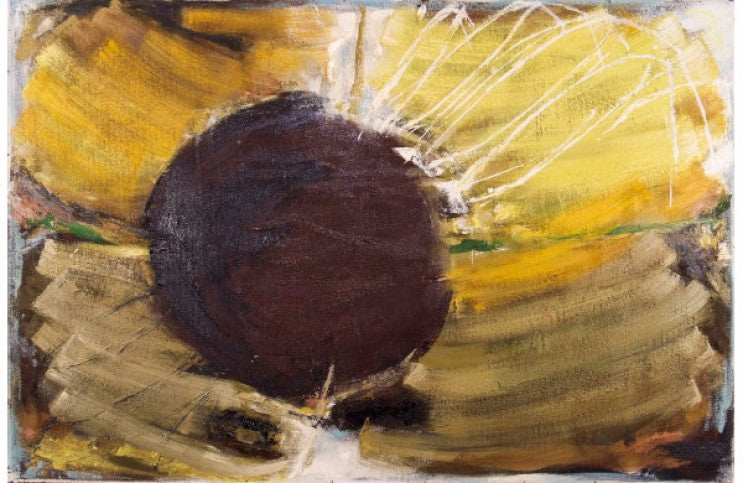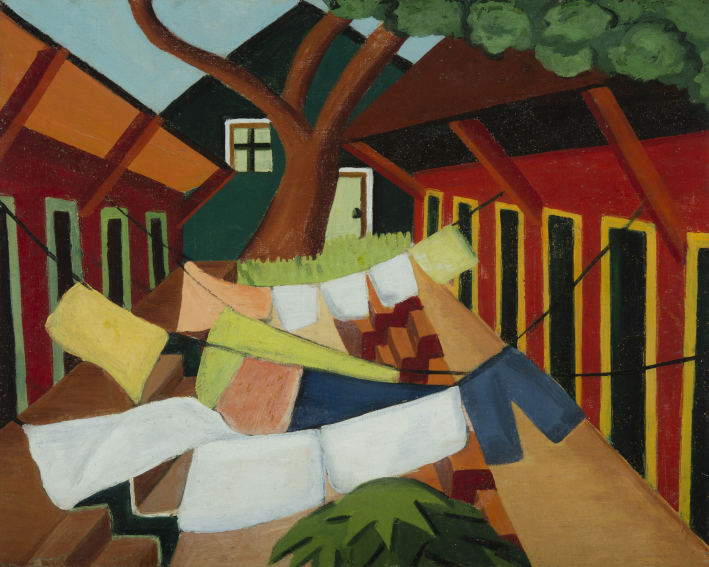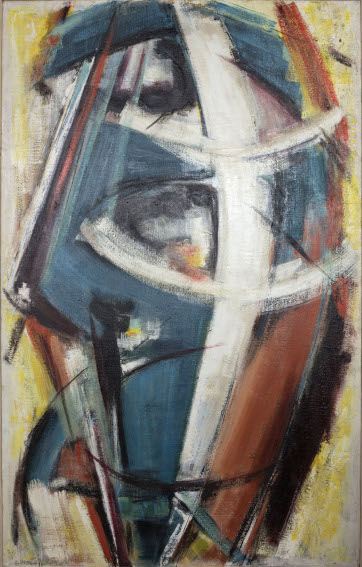
Dusti Bongé, A Force of Abstract Expressionism
If you are like me, the first thing you thought when you saw the title of this article is, “Who is Dusti Bongé?” It is all too often the case that little connection exists between the talent of an artist and the mark they leave on the history books. Bongé was born Eunice Lyle Swetman in Biloxi, Mississippi in 1903. She started out not as a painter, but as an actor. Her nickname Dusti was bestowed upon her in jest by her schoolmates while studying acting in Chicago, the dirty streets of which sent her running constantly to wash her face. After Chicago, she moved to New York and found work acting on stage and in films. She married her husband Arch Bongé there. He was a self-described “cowboy artist.” After the birth of their son Lyle, the couple moved back to Biloxi, a place they considered more conducive to raising a child. That was when, according to family lore, Bongé began her painting career in earnest. It happened after an argument with her husband. She drew Arch a picture as amends, and left it for him on his easel. Arch had studied art in several prestigious academies, and immediately recognized the talent that was evident in the simple picture his wife had made for him. He encouraged her to continue, and perhaps most importantly, suggested she avoid studying art in school, and follow her own instincts instead. Tragically and unexpectedly, Arch died a couple of years later. Bongé took over his studio, and so began what would become a lifelong evolution as an artist. The extraordinary story of that evolution is not one most people are familiar with today, but a new book by museum director, gallery founder, and art historian J. Richard Gruber, titled Dusti Bongé, Art and Life, aims to change that. On its heels, The Mississippi Museum of Art will also present the retrospective exhibition Piercing the Inner Wall: The Art of Dusti Bongé this spring. Together, the book and the exhibition present a convincing argument that the overlooked Bongé was indeed “one of the most important female artists in twentieth-century American art.”
The Path to Abstraction
The earliest paintings Dusti Bongé created were figurative scenes that explored her surroundings—the Biloxi of the 1940s. Works like Where the Shrimp Pickers Live (1940) and Shrimp Boats at the Dock, Biloxi, MS (1940) are vivid and colorful, showing a strong instinct for captivating visual storytelling. It is clearly evident in these early paintings that Bongé possessed a natural love for plastic elements like shape, form, line, texture, and color relationships. Around 1945, she perceived that perhaps Surrealism could offer her an entry point into a more abstract aesthetic celebration of these formal elements, unattached to story. Paintings such as those in her “Circus” series—inspired by an actual circus—and her “Keyhole People” series—featuring elongated, anthropomorphic forms in dreamlike landscapes—focus less on narrative content, and more on the abstract emotive potential of visual elements.

Dusti Bongé - Where the Shrimp Pickers Live, 1940. Oil on canvas, 16 x 20. Collection of the Mississippi Museum of Art, Jackson. 1999.012.
Bongé abandoned figuration altogether in the mid 1950s, embracing a fully abstract approach grounded in the same concerns preoccupying many of her Abstract Expressionists friends back in New York. She mobilized strong gestural marks, impasto surfaces, and brooding color relationships, creating a stunning body of work that fully translates the early promise of her figurative and Surrealist paintings. Many of her Abstract Expressionist paintings are untitled, or titled only in reference to their colors, but some were given emotive names such as “Ecstasy,” “essence,” or “Dance.” The large-scale “Floats a Yellow Memory” (1959) is among her most prescient works, bridging subconscious, Abstract Expressionist mark making with the transcendent strivings of the Color Field painters.

Dusti Bongé - Sails, 1955. Oil on linen. Collection of the Ogden Museum of Southern Art, Gift of the Dusti Bongé Art Foundation.
A Constant Striving
Despite the fact that Bongé is not as well known today as many of her contemporaries, in her time she did achieve a notable measure of success. She was one of the few female artists to have her work exhibited at the Betty Parsons Gallery. She had five solo exhibitions there between 1956 and 1975. At each one, Bongé demonstrated that she was always interested in pushing her methods forward and looking for new pathways into the unknown. One of her last Parsons exhibitions featured fiberglass window installations designed to filter the incoming light, along with three-dimensional paintings that were viewable from all sides. Such bodies of work signal an artist who was completely comfortable making definitive departure from her past achievements. That spirit of experimentation continued well into the 1980s and 90s, when Bongé created her most personal bodies of work: the “Voids” series and a body of tiny works made on Joss paper.

Dusti Bongé - Void #4 (detail), 1982. Oil on canvas. Collection of the Dusti Bongé Art Foundation.
The “Voids” were floating, orb-like forms that seem to glow and vibrate on the surface of the canvas. The Joss paper works were painted on a type of delicate bamboo paper commonly used in burnt offerings in Chinese ancestral ceremonies. The paper comes pre-decorated with little silver or gold squares in the center, and Bongé reveled in creating compositions in which the square appeared to have naturally emerged as part of the work. Whether it was her spirit of experimentation that caused a repetition-obsessed art market to forget about her, or it was her gender that kept Bongé out of the history books until now, regardless, Bongé seems to have taken her career in stride. On the website of her grandson, who is a photographer, I found a bit of advice that she apparently gave to her son, who also became a photographer after realizing he had no propensity for drawing. Bongé told him, “Honey, if you are cursed with an art, then find another way to make a living.” She clearly understood making a living is only part of making a life.
Piercing the Inner Wall: The Art of Dusti Bongé opens 20 February and will be on view through 23 May, 2021 at Mississippi Museum of Art. Dusti Bongé, Art and Life is available in bookstores everywhere.
Featured image: Dusti BongeÌ - Death of Maggie/Sunflower Dream No. #1, 1958. Oil on masonite. The Paul BongeÌ Collection
All images used for illustrative purposes only
By Phillip Barcio






